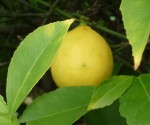Why do a ‘food plant at home’ survey ?
A survey like this can raise awareness of :
- food miles – food grown at home has as low food miles as you can get, so it adds little to greenhouse and climate problems.
- sustainability – It’s acting locally, thinking globally
- healthy food– it’s as fresh as you can get, and you know exactly what went in to growing it.
- healthy exercise – get out from sitting at the screen and do some productive exercise
- (part-time) family farming – helping understanding of the many people elsewhere who are full-time family farming
- home-school links – draws on experiences at home as worthy of study at school
- hypothesize (guess) about what the community is really like eg:
- How many different types of plants are being grown in our community?
- What is the most common?
What to do?
An example of how simple a survey can be is the one that I ran in the Wimmera, for World Environment Day 2014 under the the theme ‘Raise your voice, not the sea level‘. Both schools and the general community were invited to participate.
- For the community, a general invitation by news release news 4 backyard family farming WED (360 kb pdf )
- For schools, suggestions on how to do this, (covering English, Maths,Science and Sustainability)
- how to set the survey up and conduct in the classroom in food plants in home gardens WED survey (60kb pdf).
- then collect the data, and collate it* so that it can be shared-
- as tables eg food-plants-in-home-gardens-WED-data (356kb pdf)
- in visual ways, like graphs, , eg food-plants-in-home-gardens-WED-results (173 kb pdf) or food-plants-in-home-gardens-DPC (113kb pdf). (Nb download pdfs before printing)
* Note when reporting the survey, tomatoes poses an interesting problem. Technically they are a fruit, but most people reported them in their vegetable grouping. How should you report them, will depend on the key purpose of your report. I have left them as vegetables which is how the respondents saw them as this was a survey of what they were growing. Also consider, changes to results that need to be followed through to results, if your purpose in using this data is different, and you put the tomatoes in with the fruits.
The replies were not as many as I’d hoped for, but they did cover a diverse enough area of the Wimmera, and I have also used them to show how the data can be processed. So I can present this summary about the Wimmera regional community, fairly confidently for answers to the questions raised at the top…
- Fruits, vegetables, herbs and nuts were found to be being grown in family gardens in these Wimmera survey. Fruit plants were grown by the largest number of households and the nuts were least grown. (Read the ‘data’ pdf above for the range of plants and numbers for each)
- The food plants found to be most grown in this survey were: a yellow coloured citrus fruit, a red coloured vegetable* and 3 herbs. (Read the ‘results’ pdf above for their names!)
* see note above
Since then I have conducted this survey with another group in the Wimmera – the Dimbool Probus Club, and found that the key results above about the most common plants were the same and the average number of plants were similar. (Read ‘DPC’ pdf above)
If you do a survey like this , would you like to share your results here too?
eg Dimboola Probus Club food plants in home gardens survey results (pdf above).
